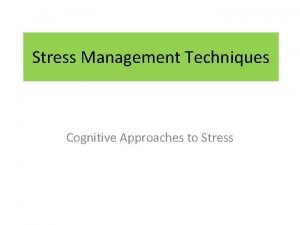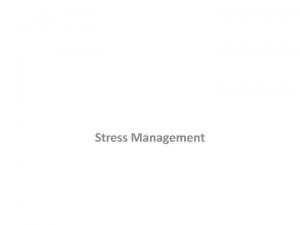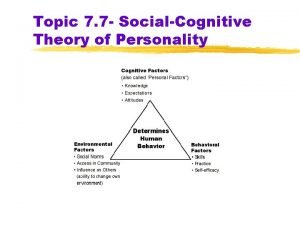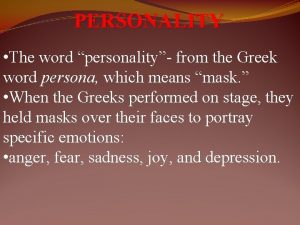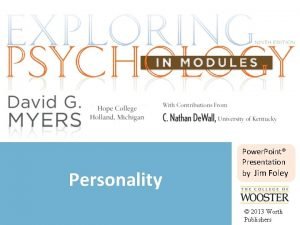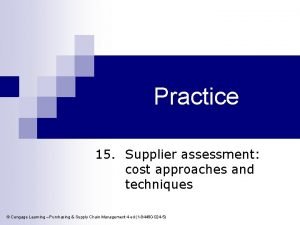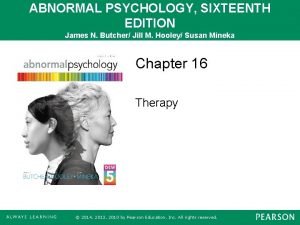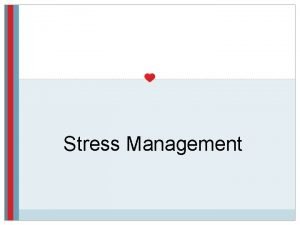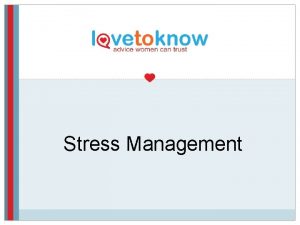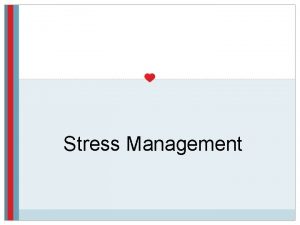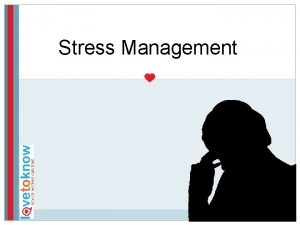Stress Management Techniques Cognitive Approaches to Stress Cognitive










- Slides: 10

Stress Management Techniques Cognitive Approaches to Stress

Cognitive Psychology: Basic Assumptions • If we want to know what makes people tick then the way to do it is to figure out what processes are actually going on in their minds. • Cognition literally means “knowing”. Cognitive Psychologists study cognition ”the mental act or process by which knowledge is acquired” • They focus on the way humans process information, looking at how we treat information that comes in to the person (what behaviourists would call stimuli) and how this treatment leads to responses.

Rational Vs Distorted Rational thinking Distorted thinking Thinking based on evidence Thinking based on limited evidence Conclusions are logical Conclusions are irrational Functional beliefs which are useful Dysfunctional beliefs Result: Happy, competent, realistic people Result: Problematic behaviour, fears and anxieties How does our thinking get distorted?

How do we use cognitive approaches in psychology? Some psychologists use cognitive behavioural therapy (CBT) to help people challenge their distorted thinking. What people think and believe determines their behaviour Emotional problems are the result of distorted thinking - they arise out of dysfunctional beliefs Therapists can challenge this negative and distorted thinking, which can help people overcome their emotional and behavioural problems

Cognitive Approaches • Cognitive Restructuring • Rational Emotive Therapy Changing how a person thinks about the stressful situation and their own ability to cope with stress

Cognitive Restructuring To replace negative and self-esteem lowering thoughts the person may have when faced with stress.

Faulty Cognition (Emotional Response) Oh no it’s spoiled There is no point I’m sick of it Everyone hates me Why is it always like this This always happens to me I am jinxed Healthy Cognition (Rational Response)

Faulty cognitions are replaced Faulty Cognition (Emotional Response) Healthy Cognition (Rational Response) Oh no it’s spoiled One thing has gone wrong, one is not all There is no point There is always some point I’m sick of it I’m sick of this particular thing Everyone hates me Some people dislike me, but most like me Why is it always like this It is not always like this This always happens to me This kind of thing happens now and again I am jinxed Everyone is unlucky sometimes

Rational-Emotive Therapy (Ellis, 1962) People often CATASTROPHISE about events, blow things out of proportion. This makes the person feel totally unable to cope and manage the stressor as it seems overwhelming and unmanageable. RET – replaces catastrophic / negative thoughts with more realistic ones.

Activity: What dysfunctional thoughts do you have about your studies and how might you challenge them?
 Rational vs logical
Rational vs logical Individual approaches to stress management
Individual approaches to stress management Social cognitive personality
Social cognitive personality Trait theory
Trait theory The word personality comes from the greek word __________
The word personality comes from the greek word __________ Social cognitive approaches to personality
Social cognitive approaches to personality Chapter 10 stress responses and stress management
Chapter 10 stress responses and stress management Approaches to language testing
Approaches to language testing Cost approaches and techniques in suppler assessment
Cost approaches and techniques in suppler assessment Cognitive and non cognitive religious language
Cognitive and non cognitive religious language Cognitive therapy borrows many techniques from
Cognitive therapy borrows many techniques from
